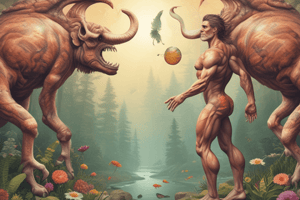Podcast
Questions and Answers
What is speciation?
What is speciation?
- The process of a new species forming from an existing population (correct)
- The alteration of a species' physical characteristics
- The extinction of a species
- The mixing of two different species into one
What type of speciation occurs when populations are geographically separated?
What type of speciation occurs when populations are geographically separated?
- Allopatric speciation (correct)
- Phenotypic speciation
- Sympatric speciation
- Genotypic speciation
Which of the following is NOT a barrier that can lead to speciation?
Which of the following is NOT a barrier that can lead to speciation?
- Behavioral differences
- Temporal differences
- Environmental adaptation (correct)
- Geographical separation
What is the term for hybrids that are unable to produce fertile offspring?
What is the term for hybrids that are unable to produce fertile offspring?
What role does genetic drift play in evolution?
What role does genetic drift play in evolution?
What is a gene pool?
What is a gene pool?
What does gradual evolution imply?
What does gradual evolution imply?
What is a key consequence of two populations becoming isolated?
What is a key consequence of two populations becoming isolated?
What is the primary driver of evolution that favors individuals with traits suitable for their environment?
What is the primary driver of evolution that favors individuals with traits suitable for their environment?
Which of the following best describes evolution?
Which of the following best describes evolution?
What does the fossil record provide evidence for?
What does the fossil record provide evidence for?
How does selective breeding differ from natural selection?
How does selective breeding differ from natural selection?
What aspect of guppy coloration was demonstrated by John Endler's research?
What aspect of guppy coloration was demonstrated by John Endler's research?
Why is mitochondrial DNA important for studying evolution?
Why is mitochondrial DNA important for studying evolution?
What does comparing DNA base sequences between species help to highlight?
What does comparing DNA base sequences between species help to highlight?
What type of variation contributes to natural selection?
What type of variation contributes to natural selection?
Flashcards are hidden until you start studying
Study Notes
Evolution
- Cumulative change in heritable characteristics of a population over time
- Species are groups of organisms that can interbreed and produce fertile offspring, sharing common characteristics
- Variation (environmental and genetic) influences chances of survival and reproduction
- Natural Selection is a key driver of evolution: individuals with advantageous traits survive longer, reproduce more, and pass on their traits
- All species have evolved from pre-existing ones
Evidence for Evolution
- Fossil Record: Preserved remains of organisms show changes over millions of years
- Radiometric Dating: Studying the natural radioactivity of fossils to determine their age
- Selective Breeding: Humans intentionally choose desirable traits to breed in plants and animals (artificial selection)
- John Endler's Guppy Experiment: Demonstrated that predator presence influences guppy coloration, with more colorful males found in areas with fewer predators
- DNA Base Sequence Comparison: Highlighting similarities and differences between species
- Mitochondrial DNA (mtDNA): Mutates faster than nuclear DNA and is not mixed with the father's DNA, making it useful for tracking recent evolutionary relationships
Speciation
- Formation of new species from existing populations through isolation and different evolutionary paths
- Population: A group of organisms of the same species living in the same area at the same time
- Barriers to gene flow between populations drive speciation:
- Geographical Separation: Physical barriers like mountains, rivers, or roads
- Temporal Differences: Breeding at different times
- Behavioral Differences: Incompatible mating rituals
- Sympatric Speciation: Occurs within the same geographical area
- Allopatric Speciation: Occurs in different geographical areas
- Example: Bonobos and Chimpanzees are geographically separated
- Infertile Hybrids: Offspring of two different species, often sterile due to chromosome incompatibility (e.g., mules with 63 chromosomes)
Gene Pool and Evolution
- Gene Pool: All the genetic information in a reproducing population
- Allele Frequency: Proportion of a specific gene variant in a population
- Genetic Drift: Random changes in allele frequencies, especially significant in small populations, leading to genetic divergence between isolated groups
- Gradual Evolution: Species evolve slowly and continuously over long periods of time through the accumulation of small, incremental changes.
Studying That Suits You
Use AI to generate personalized quizzes and flashcards to suit your learning preferences.




